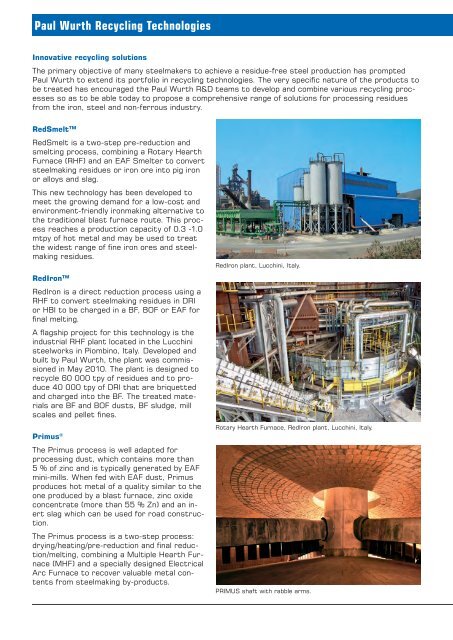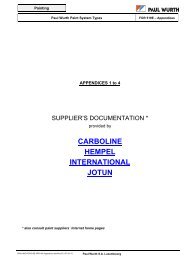Recycling Technologies RedSmelt - Paul Wurth
Recycling Technologies RedSmelt - Paul Wurth
Recycling Technologies RedSmelt - Paul Wurth
You also want an ePaper? Increase the reach of your titles
YUMPU automatically turns print PDFs into web optimized ePapers that Google loves.
<strong>Paul</strong> <strong>Wurth</strong> <strong>Recycling</strong> <strong>Technologies</strong><br />
Innovative recycling solutions<br />
The primary objective of many steelmakers to achieve a residue-free steel production has prompted<br />
<strong>Paul</strong> <strong>Wurth</strong> to extend its portfolio in recycling technologies. The very specific nature of the products to<br />
be treated has encouraged the <strong>Paul</strong> <strong>Wurth</strong> R&D teams to develop and combine various recycling processes<br />
so as to be able today to propose a comprehensive range of solutions for processing residues<br />
from the iron, steel and non-ferrous industry.<br />
<strong>RedSmelt</strong> TM<br />
<strong>RedSmelt</strong> is a two-step pre-reduction and<br />
smelting process, combining a Rotary Hearth<br />
Furnace (RHF) and an EAF Smelter to convert<br />
steelmaking residues or iron ore into pig iron<br />
or alloys and slag.<br />
This new technology has been developed to<br />
meet the growing demand for a low-cost and<br />
environment-friendly ironmaking alternative to<br />
the traditional blast furnace route. This process<br />
reaches a production capacity of 0.3 -1.0<br />
mtpy of hot metal and may be used to treat<br />
the widest range of fine iron ores and steelmaking<br />
residues.<br />
RedIron TM<br />
RedIron is a direct reduction process using a<br />
RHF to convert steelmaking residues in DRI<br />
or HBI to be charged in a BF, BOF or EAF for<br />
final melting.<br />
A flagship project for this technology is the<br />
industrial RHF plant located in the Lucchini<br />
steelworks in Piombino, Italy. Developed and<br />
built by <strong>Paul</strong> <strong>Wurth</strong>, the plant was commissioned<br />
in May 2010. The plant is designed to<br />
recycle 60 000 tpy of residues and to produce<br />
40 000 tpy of DRI that are briquetted<br />
and charged into the BF. The treated materials<br />
are BF and BOF dusts, BF sludge, mill<br />
scales and pellet fines.<br />
Primus ®<br />
The Primus process is well adapted for<br />
processing dust, which contains more than<br />
5 % of zinc and is typically generated by EAF<br />
mini-mills. When fed with EAF dust, Primus<br />
produces hot metal of a quality similar to the<br />
one produced by a blast furnace, zinc oxide<br />
concentrate (more than 55 % Zn) and an inert<br />
slag which can be used for road construction.<br />
The Primus process is a two-step process:<br />
drying/heating/pre-reduction and final reduction/melting,<br />
combining a Multiple Hearth Furnace<br />
(MHF) and a specially designed Electrical<br />
Arc Furnace to recover valuable metal contents<br />
from steelmaking by-products.<br />
RedIron plant, Lucchini, Italy.<br />
Rotary Hearth Furnace, RedIron plant, Lucchini, Italy.<br />
PRIMUS shaft with rabble arms.




